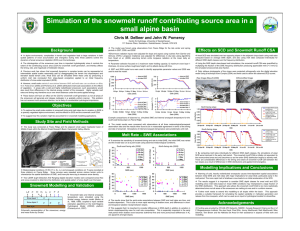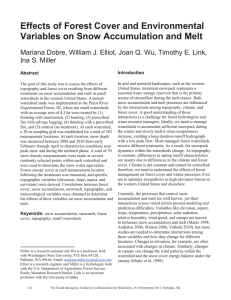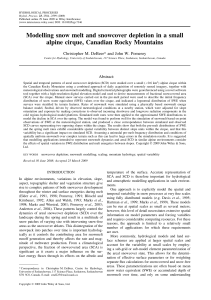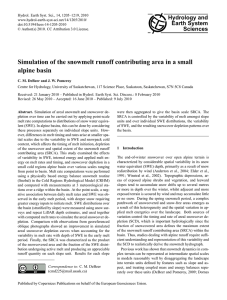Mountain hydrology of the semi-arid western U.S.: Research needs, opportunities & challenges
advertisement
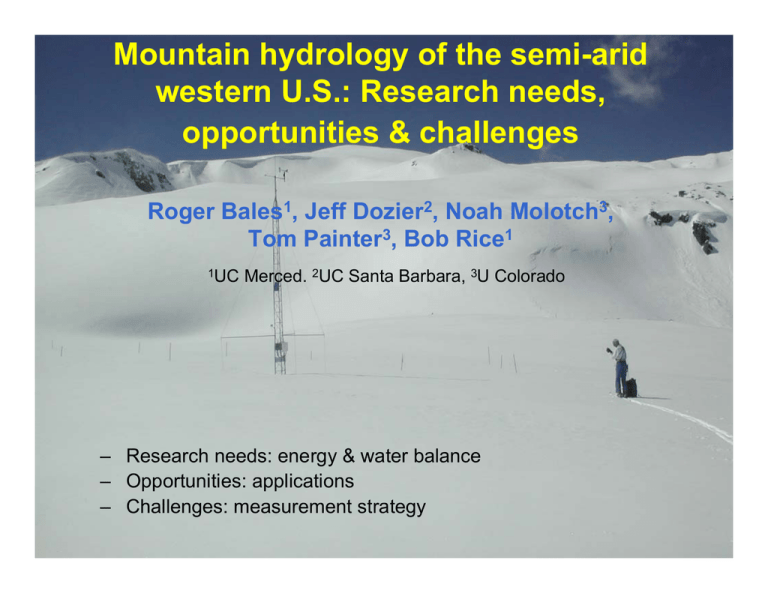
Mountain hydrology of the semi-arid
western U.S.: Research needs,
opportunities & challenges
Roger Bales1, Jeff Dozier2, Noah Molotch3,
Tom Painter3, Bob Rice1
1UC
Merced. 2UC Santa Barbara, 3U Colorado
– Research needs: energy & water balance
– Opportunities: applications
– Challenges: measurement strategy
Much of the semi-arid west derives its water supply from
intensively managed mountain ranges
Dec 7, 2004
Being in the 6th year of drought has focused attention
on western water. It has made scientists & decisionmakers alike push for new measurements &
understanding of mountain hydrology to close critical
knowledge gaps. This new understanding is needed
for longer-term sustainable water management.
http://drought.unl.edu/dm
Despite the hydrologic importance of mountainous
regions, the processes controlling energy & water
fluxes within & out from these systems are not
well understood.
Particular areas for investigation
– precipitation patterns – orographics
– energy balance - modeling
– partitioning of snowmelt & rainfall on the ground
– water balance – scaling point to catchment to
range
Changes in April 1 Sierra Nevada snow
124°W
123°W
122°W
121°W
120°W
119°W
42°N
118°W
124°W
117°W
123°W
122°W
121°W
120°W
119°W
118°W
117°W
42°N42°N
Central Valley Drainage
42°N
Sierra Nevada Drainage
April SWE, mm
85 - 400
400 - 650
41°N
41°N41°N
41°N
650 - 900
Central Valley Drainage
900 - 1200
Sierra Nevada Drainage
1200 - 2017
April 1 SWE change, mm/yr
-7.1 to -3
40°N40°N
40°N
40°N
-3 to -1
-1 to +1
+1 to +3
+3 to +7.8
39°N
39°N39°N
38°N
38°N38°N
38°N
37°N
37°N37°N
37°N
36°N
36°N36°N
36°N
35°N
35°N35°N
35°N
123°W
122°W
121°W
0 25 50
120°W
100
119°W
150
118°W
Kilometers
200
117°W
124°W
39°N
123°W
122°W
121°W
0 25 50
120°W
100
119°W
150
118°W
Kilometers
200
Changes in April 1 Sierra Nevada snow
6
N of mean latitude
Changes in
orographics?
∆ SWE, mm/yr
4
2
0
-2
S of mean 38.3oN
-4
-6
1500
2000
2500
3000
Elevation, m
3500
Meteorological & climatic controls on precipitation in
mountains: spatially, interannually?
Energy balance: spatial variability of snow
surface albedo above treeline
May 28
Albedo measured from AVRIS
May 05
USACE –
empirical
std. dev.
AVIRIS –
measured
>3
3-2
2-1
+- 1
-2 - -1
-3 - -2
0
1
2 km
αmean = 0.664
age = 11 dy
Measured albedo can be quite
different from empirical estimates
snowmelt
cm dy-1
north-facing
slopes
0
1.4
2.9 4.3
Modeled snowmelt is very
sensitive to albedo on slopes
where solar radiation dominates
Small spatial variation in albedo measured by AVRIS — but large changes with
grain size as snow ages — depends on elevation, latitude, orientation, wind
exposure, dust deposition
Test basins for radiation balance & remote sensing needed across range of
variability in mountains
Molotch et al., GRL, 2004
Energy balance in mountain forest
Issues & research needs are somewhat different
— turbulent fluxes, vegetation control on
heterogeneity
pre-monsoon
monsoon
{
latent
sensible
post-monsoon
winter
Daily cycles of turbulent fluxes at Mt Bigelow, AZ.
2400 m elevation, 2nd growth Ponderosa PineDouglas Fir forest
Brown-Mitic et al., in press
Scaling from point to basin
surface characterization
snowmelt modeling
basin-scale modeling
surface characterization
micromet network
Measurement clusters: flux towers &
water-balance instrumentation arrays
Pilot deployments over past
4 yr to develop concept
sonic anemometer
& Licor
irt
net radiometer
4-way radiometer
wind, RH &
temp profiles
irt, net
rad.
soil moisture & heat flux,
soil & tree temperature
Co-locate soil moisture
with snow measurements?
Similarity in Tair & RH —
differences in net radiation
(reflected in surface
temperature) & potential for
heat transfer
Scaling mountain
water balance
plot/hillslope
soil moisture
basin
remote sensing
SCA
albedo
vegetation
snow distribution
melt timing
snow distribution
partitioning
infiltration
ET
runoff
micromet
recharge
ground/RS
SWE
precip
radiation
EB
topography
fluxes
ground
How to blend measurements
from multiple scales, with
integrated modeling
schemes?
soil moisture
infiltration &
recharge
micromet
bedrock
soils
Lack of integrated measurement strategies &
data/information systems for mountain
hydrologic data hamper improvements to
understanding the aforementioned processes
Topics:
- precipitation & snowcover — blend of remote
sensing & ground-based measurements
- integrated water balance measurement
strategies: measurements as a research area
MODIS fractional SCA & grain size
MODIS has sufficient spectral sampling to estimate grain size & thus albedo,
as well as fractional SCA, within a 500 m pixel
Mountain snowcover is generally not continuous at the 500-m scale — binary
snowcover models consistently overestimate basin-wide SCA & albedo
Snow under trees remains a challenge — ground truth needed for research
The question remains: how best to use knowledge of snowcover from remote
sensing as part of an integrated measurement & modeling strategy
Painter and Davis, in preparation
Mountain precipitation
Research needs cover most aspects of the problem:
– Measurement at a point
– Ground-based network design
– Integration of remotely sensed & ground-based measurements
The accuracy provided by existing networks simply is not adequate
Snow course & snow telemetry sites
– Point measurements of SWE — not quantitative measures of basin-scale
SWE
– Established as index sites to estimate seasonal runoff using statistical
models — located at sites with persistent snowcover
– Emerging water resources decision support systems & hydrologic models
are based on mass balance — quantitative SWE estimates are a top
priority
April SWE bias at 4 Colorado sites
cm
120
2001
cm
40
2002
30
80
20
40
10
SNOTEL
survey
sdev & range
0
1
4
5
Site
6
0
1
4
5
6
Site
SNOTEL site generally has much more snow
than does surrounding area
How to design representative network?
Molotch et al., in preparation
Optimal locations for measuring mean SWE
1
5 3420April deviance = 8 cm
3300
3390
3450
3300
3180
April deviance
= 0.61 cm
Based on topography, vegetation, energy balance
factors, it is possible to design a network to
minimize the error in spatial estimates
Existing sites generally do not fall within that area
Network design is still a research issue
New technology must also be used to extend point
measurements — lower cost, less intrusive
Molotch et al., in preparation
Concluding thoughts
– Current ability to quantitatively estimate water fluxes &
reservoirs in mountains is woefully inadequate (also
ecological & biogeochemical linkages)
– Economic value of & societal demand for new
knowledge & tools for mountain hydrology is very large
– Advances will require sustained investments in new
measurements & infrastructure, including data &
information systems (plus research)
– Measurement strategies will rely heavily on remote
sensing — need complimentary ground-based systems





